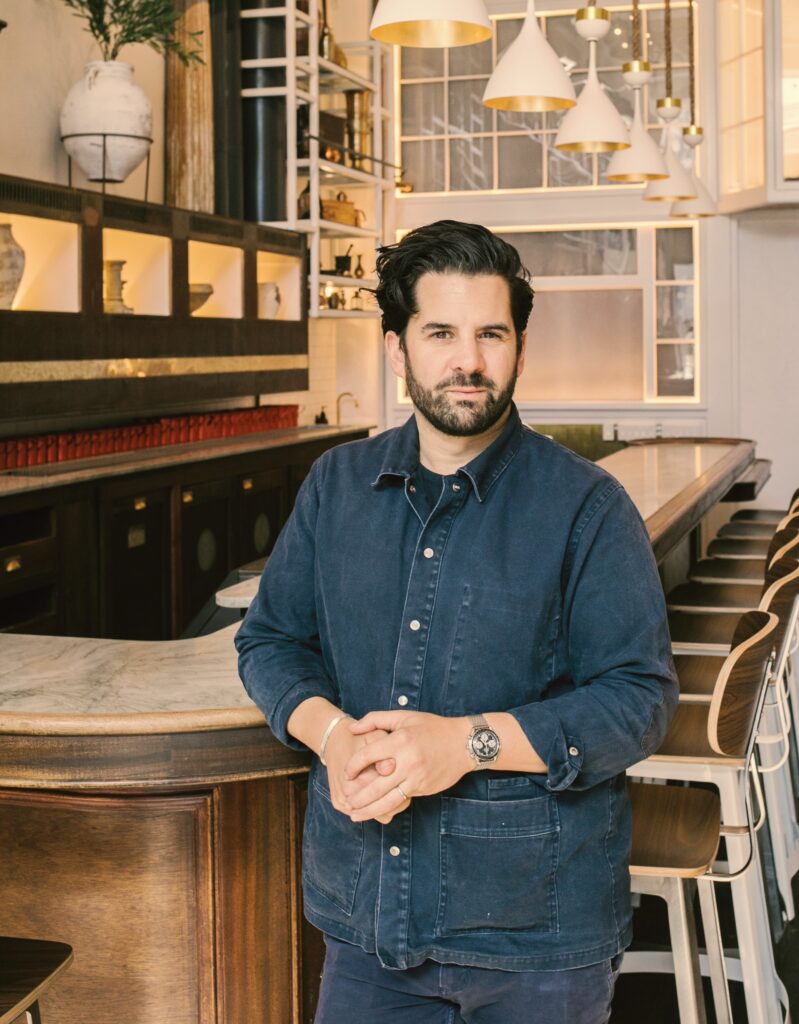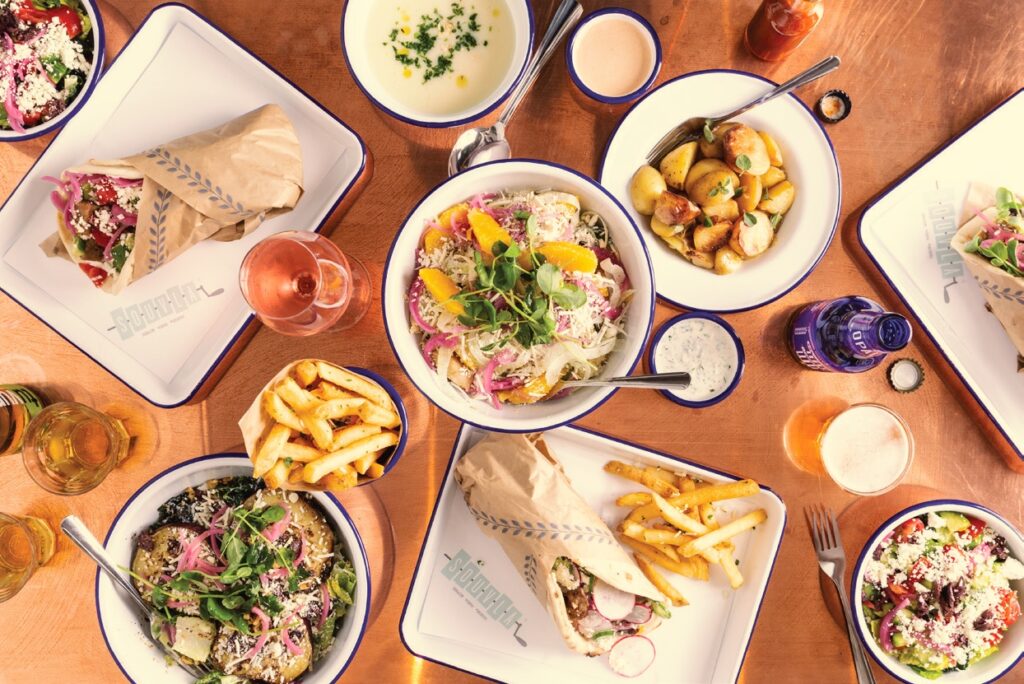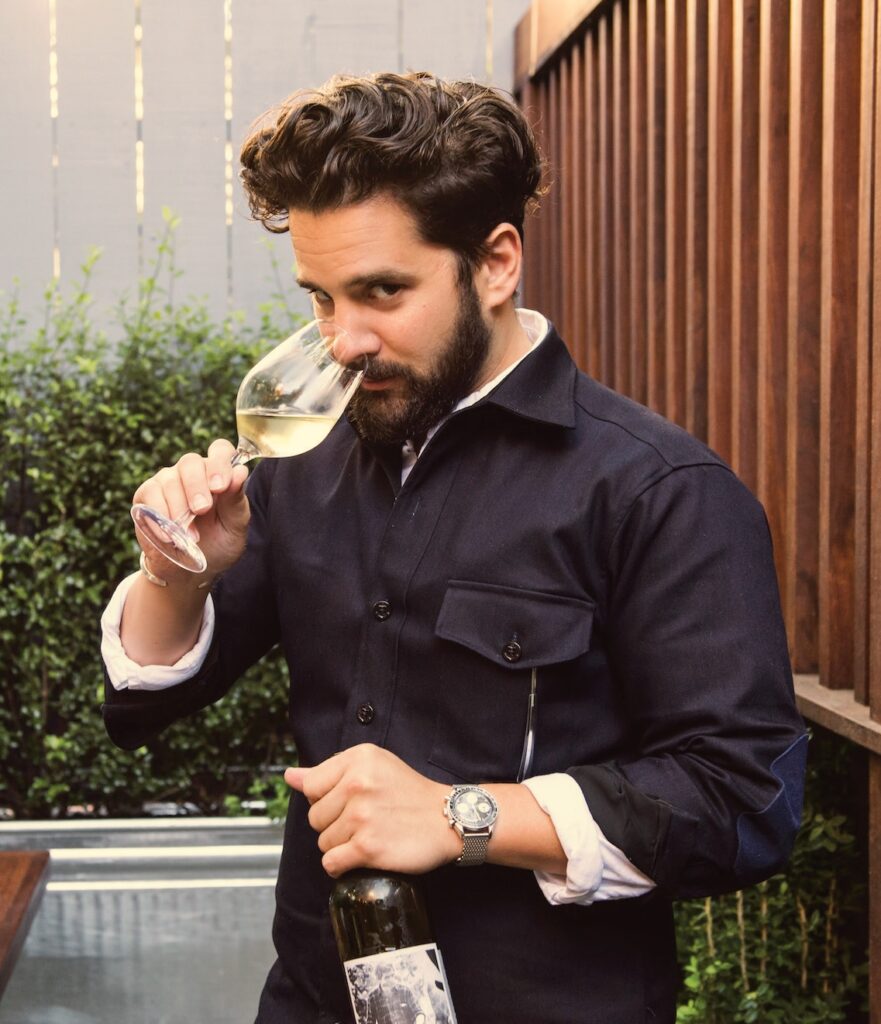San Francisco Success Story
Posted by estiator at 11 May, at 13 : 49 PM Print
COVER STORY

The inspiring journey of Charles Bililies and Souvla. By Michael Kaminer
A leftover sandwich changed Charles Bililies’ life.
The year was 2010. Bililies, who was working as a chef at some of San Francisco’s top restaurants, hosted a lamb roast in his backyard. “I made myself a sandwich the next day with what was left,” Bililies, 40, tells Estiator. “Lamb, pita, beautiful heirloom tomatoes. I thought, This is delicious. Why can’t I find it anywhere?”
Fast-forward to 2023. That aha moment has mush- roomed into Souvla, a beloved San Francisco restaurant brand with five locations—and a sixth on the way. Souvla has become one of the city’s treasures, a local business so beloved that customers who meet there for dates often hire Bililies to cater their weddings. “We’ve become a part of people’s lives, and part of the cultural fabric of San Francisco, in ways I had never envisioned,” he says.
Along the way, Bililies has had to navigate a culling of San Francisco’s tech industry, a crowded fast-casual field, and—of course—the pandemic.
But as he explains it, Souvla has brought something singular to San Francisco’s dining scene—and sticking to that vision, rather than pursuing fast growth, has been crucial to its success. Bililies also helped pioneer an elevation of Greek street food that reflects a broader reappraisal of ethnic cuisine.
“After that delicious leftover sandwich, I started thinking about how gyros and souvlakis proliferated in the U.S. in the 1970s,” he says. “It was synonymous with true street food, late-night drunk food, highly processed mystery cone meat, and out-of-season produce. It was certainly different from what you’d find in Greece.”

Around the time of that momentous backyard barbecue, in 2010, “we also started seeing the elevation of street and ethnic foods,” he says. “I took a beat. No one has really modernized the gyro or souvlaki sandwich. Here I am in Northern California with access to the most incredible produce, dairy, and meats. And when you think about the architecture of these sandwiches, with warm, fluffy bread, cool yogurt, and hot meats, you have the making of a great sandwich. We started riffing on that, and it started the journey of iterating the product that would become the core of our menu: the Souvla sandwich.”
Bililies started his sandwich experiments while still employed by renowned chef Thomas Keller at the legendary French Laundry in Yountville, California. “I was the liaison between the kitchen, Thomas, and the rest of the world,” he says. “I had amazing opportunities to travel and interact with great people. Then we Thomas opened [nearby] Bouchon Bistro, I developed its first management-training program. So I had this journey from the kitchen to the back office to the dining room to ownership and operations.”
After years of conceptualizing and planning, the first Souvla opened in the hip Hayes Valley neighborhood in 2014. “We decided to go back to the real roots of why we cook these meats. I’m a proud Greek-American born to Greek parents, and Souvla is a direct reflection of my relationship with my Greek heritage,” Bililies says. Bililies’ mother hails from Halandri, near Athens; his father is U.S.-born. His paternal grandfather, also named Charles Bililies, was a pioneering Boston estiator who launched an innovative restaurant/vocational school called the Brass Lantern.

Along with heritage, “we wanted to bring some transparency,” Bililies says. “Americans have mixed feelings about gyros because of highly processed meats. So bringing it back to its roots also meant a whole leg of lamb or a whole chicken, put on display. We’re not hiding what we’re doing or what we’re serving, and we’re proud of where it comes from.”
Souvla’s precisely edited menu is familiar enough to make customers comfortable, but creative enough to feel fresh. There are just four main food choices, each available in a Souvla sandwich or salad: Snake River Farms pork, Mary’s Free-Range chicken, Thomas Farms lamb leg, and roasted white sweet potato. It speaks volumes of Souvla’s stature that when Bililies added Black Sheep vegan lamb to the menu, it made national headlines.
Sides include Greek fries, “juicy potatoes,” avgolemono, and pita. Frozen Greek yogurt for dessert might come with toppings like vissino, olive oi,l and sea salt, or baklava crumbles. The chicken salad remains Souvla’s top seller, Bililies says.
Souvla also boasts the only all-Greek beverage menu in the country, according to Bililies. Along with Loux cola and Zagori water, Souvla offers carefully selected Greek wines from pro- ducers like Kir-Yianni, Alexakis, and Skouras—simply called “Greek Bubbles,” “Greek White,” or “Greek Red” on the menu. “We didn’t want customers to worry about pronouncing ‘Kir- Yianni, Akakies, Amyndeon,’” he says, laughing. “They can just order a draft red or white.” Gal’a Estate retsina rounds out the wine list, under the heading “Yes.. We Have (Good) Retsina.”
On the service side, Bililies reached back to tradition while reinventing the fast-casual experience to create something new. “We call it fast-fine,” he says. “The service, ambience, and design are all at the level you’d expect from a fine-dining experience. But we’ve combined it with the economics and business model of fast-casual, including volume and omnichannel.”
While guests order at a counter, “you see a lot of things at Souvla that you don’t see in other counter-service restaurants,” Bililies says. “Our guiding principle in designing our restaurants was that they should feel nice enough to bring someone on a date. Everything aside from the counter looks like full-service. The food is served in cool blue-enamel tableware. We use stem glasses for wine. But our price points are considerably lower than full-service.”
At the same time, the business model builds in “flexibility in how you can enjoy Souvla, whether that’s coming in for a casual lunch, dropping by for dinner, or ordering online,” he says. “Before I launched Souvla, I had worked for very high-profile chefs at the top of the industry. I got more insight into day-to- day operations, budgets, P & L. And one takeaway was that fine dining as a business model is fundamentally flawed. Customers see the accolades and awards, but it’s very costly to create those elevated experiences.
So the margins at the upper end are very tight. That’s why so many top-end chefs have casual brands in their portfolios, to support their flagships.”
Souvla’s fast-fine concept was born of that insight. “We created it to provide the service, design, and ambience of fine dining, but with the economics and business model of fast- casual, including volume and omnichannel,” Bililies says.
Likewise, Souvla created a new design vocabulary for Souvla with an “old-world elevated approach that felt really authentic—not necessarily to Greece, but to me,” he says. “It’s more modern, and not as kitschy as some other casual Greek concepts. There’s extensive use of copper, weathered wood, marble, and penny tile. All of the restaurants feature vintage copper pieces that came from my grandfather’s restaurant, or items that I bring back from my annual trips to Greece.”
After opening five restaurants in nine years, Bililies plans to expand outside of San Francisco next. The sixth Souvla, set to launch this summer, is in the Marin Country Mart, a high-end shopping, dining, and fitness development in Larkspur, about 16 miles north of San Francisco.
“We normally develop one restaurant a year, which is a great pace for us,” he says. “It’s thoughtful growth. We’re not backed by outside capital and we’re not franchised, so we can do it that way.”
Marin County, where the new restaurant is located, “is a bit more of a suburban landscape,” Bililies says. “So we have more seating and more outdoor space at that location.” The move to Marin also reflects demographic changes in San Francisco. “People have migrated outside the cities,” he says.
“Their lives change, and they move to the suburbs.”
Souvla’s growth also reflects a flourishing of Greek cuisine nationwide, Bililies says. “I travel a lot, and it’s great to see Greek concepts open across the country. It’s been pretty underrepresented. Greek wine has also been a passion of mine, and it’s great to see more of them showing up on wine lists. I hope that Souvla has played a small role in exposing people to Greek food and wine. We’re evangelists.”

Souvla Secrets
Charles Bililies on a secret to his success— and his one big mistake.
What I’ve learned: I come from several generations of entrepreneurs. My intent in building this business was to shift the traditional immigrant mentality that you have to be there all the time and touch every table. Souvla is not about me or [chef and partner] Tony Cervone. It’s a brand. I’m so proud of the team we’ve built. Some have been with us the entire nine years, some for seven or eight. All of them came up in our restaurants. In the early days, as I hired, it was intentional in not only working side by side with them, but also to mentor and guide. The key to six restaurants in nine years is great people.
My big mistake: In the early days, we wanted to bring the sights and smells of Souvla to guests. We wanted the rotisseries to be front and center, and they still are. We believed people should line up at the counter and watch meat spin while they order—like a front-row seat. So we put our point of sale in front of the rotisserie. We open the restaurant, people come in, a line forms in the dining room…and our counter servers are dripping with sweat while they’re taking orders. Having them stand in front of a wall of fire turned out not to be the best idea. So we moved the order counter next to the front door. We ended up having long lines outside the restaurant, which sent a strong signal if you were walking by. We solved an operational problem and created a great opportunity. The takeaway is that you can think, dream, and vision all you want, but you ultimately have to see it play out in real life.


















